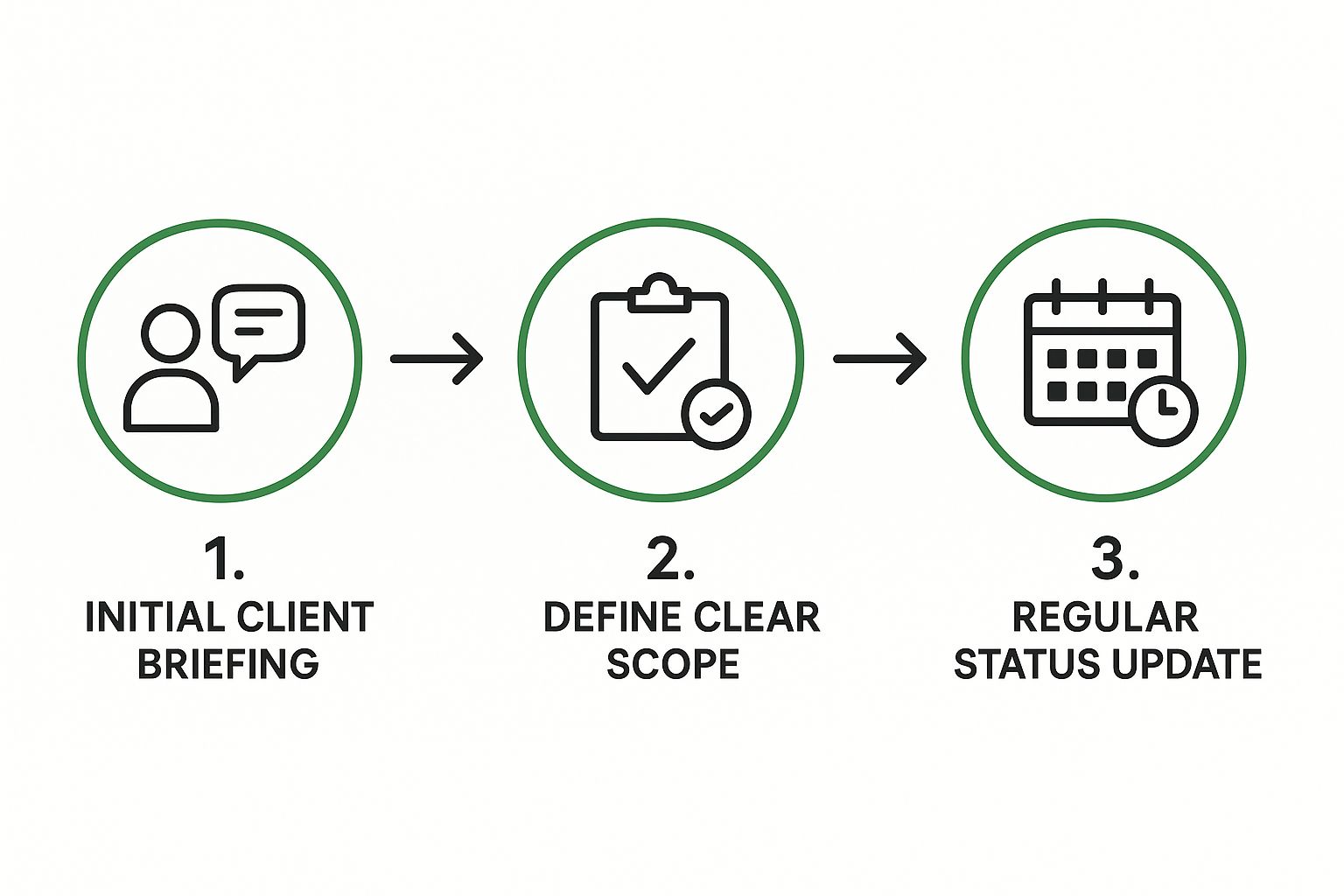How to Manage Client Expectations: Tips for Success
If you want to get a real handle on client expectations, you have to stop playing defense. The secret isn't putting out fires; it's preventing them from starting in the first place through a constant loop of discovery, clear communication, and checking your work against their vision. This shift is what separates successful partnerships from projects that spiral into frustration and rework.
The Critical First Step in Managing Expectations
Let’s be real. The space between what a client dreams up and what your team can actually deliver is a danger zone. It’s where most projects fall apart. This isn’t some new-age business challenge, either—it's a fundamental gap in human communication that has always existed. To bridge it, you need a solid framework that builds clarity from the very first conversation.
The hard truth is that most companies are falling short. Data from the American Customer Satisfaction Index, spanning from 1994 to 2022, shows a consistent, nagging gap between what customers expect and what businesses deliver. This persistent shortfall highlights just how vital it is to get alignment right from the start.
The heart of managing expectations isn't about telling clients to want less. It’s about building a shared ladder with them, rung by rung, so you can both climb to the same destination together.
The Three Pillars of Expectation Management
I've found that success in this area boils down to three core principles. Think of them as the foundation for the entire client relationship. If you build your process on these pillars, you’ll sidestep the miscommunication that dooms so many projects.
Here’s a quick breakdown of this framework:
The Three Pillars of Expectation Management
| Pillar | What It Means | Key Action |
|---|---|---|
| Discovery & Definition | Getting past the surface-level "ask" to find out what success really looks like to the client, including their unspoken assumptions. | Run a deep-dive kickoff meeting to nail down goals, scope, and communication rules, then put it all in a shared document. |
| Proactive Communication | Setting up a reliable rhythm for updates so the client feels in the loop and confident, instead of having to chase you for news. | Stick to a predictable schedule (like a weekly summary email) and use a shared project portal for total transparency. |
| Validation & Iteration | Regularly confirming that the work you're doing still lines up with their goals, which can (and often do) change over time. | Set formal review milestones to show progress, collect feedback, and make adjustments to the plan as you go. |
This approach isn't just about project management; it's about building trust. A huge part of setting expectations early is implementing robust customer onboarding strategies that map out the entire journey. This initial work paves the way for a healthy, long-term relationship.
The whole process can be visualized as a continuous cycle.

This simple flow—briefing, scoping, and updating—is the backbone of any good system for managing expectations. It’s not a checklist you complete once; it’s a constant loop that keeps everyone on the same page.
Creating a Shared Definition of Success
 Real alignment starts way before the first deliverable is ever sent. If you want to get a handle on client expectations, you have to move past vague goals and build a concrete, shared vision of what a “win” actually looks like. The kickoff meeting is your golden opportunity to get this done.
Real alignment starts way before the first deliverable is ever sent. If you want to get a handle on client expectations, you have to move past vague goals and build a concrete, shared vision of what a “win” actually looks like. The kickoff meeting is your golden opportunity to get this done.
It’s all about digging deeper. A client might say they want "more social media engagement," but that phrase means something different to everyone. Your job is to translate that fuzzy desire into hard numbers that both you and your client can agree on and track. This is where you turn assumptions into agreements.
Developing the Success Spectrum
I’ve found that one of the most effective tools for this is what I call a "Success Spectrum." It's a straightforward document you build with your client that maps out what project outcomes look like at different levels of success. This simple tool gets you away from a basic pass/fail grade and introduces some much-needed nuance.
For a social media campaign, that spectrum might look something like this:
- Exceeding Expectations: We generate over 50 qualified leads and see a 15% jump in follower growth, with a few posts going viral.
- Meeting Goals: We hit our target of 25-49 qualified leads, grow followers by 10%, and meet every single content deadline.
- Needs Improvement: We bring in fewer than 25 qualified leads or see no meaningful increase in our follower count.
Doing this one simple exercise gets rid of so much ambiguity down the line. Before any work even begins, everyone knows exactly what target they’re aiming for. This document becomes your north star for every performance conversation you have later on.
Uncovering Hidden Assumptions
The kickoff meeting isn’t just about the work; it’s an investigation. You're trying to uncover your client's unwritten rules of engagement. What does "urgent" really mean to them? Are we talking a 24-hour turnaround, or is the end of the week okay?
Don't just ask what the client wants. Ask how they want to work together. The 'how' is often more critical for a healthy partnership than the 'what.'
To get these answers, you need to ask direct questions about their process and communication habits. Nailing this down upfront saves a world of frustration later.
Key Questions to Uncover Assumptions:
| Topic | Example Question | Why It's Important |
|---|---|---|
| Communication | "What's your preferred way to get updates—a formal weekly email, a quick chat, or a dashboard?" | This matches your reporting style to their preference, making them feel heard and respected. |
| Urgency | "If a time-sensitive issue pops up, what's a reasonable response time to expect from our team?" | This defines your emergency protocol and stops mismatched expectations about how fast you'll reply. |
| Feedback | "Who are the key decision-makers for approvals, and what’s a realistic turnaround time for feedback?" | This clarifies the approval chain right away, preventing the bottlenecks that always derail timelines. |
By writing down the answers, you create a clear operational agreement. This document, combined with your Success Spectrum, creates a single source of truth for the entire project. For more ideas, our guide on social media management tips has some other frameworks you can adapt. Ultimately, this foundational work is what turns a simple client request into a detailed, documented partnership built to succeed.
Communicate Proactively to Build Trust

Once you’ve defined what success looks like together, the real work of managing client expectations begins. It all comes down to controlling the flow of information. Your goal should be to become so predictable and reliable with your updates that the client never even thinks about chasing you for one.
This isn’t just about providing good service; it's a core business strategy. Expectations are higher than ever. In fact, 54% of customers worldwide say they have higher expectations for customer service than they did just a year ago. That number climbs to 57% in the United States alone, proving clients want more direct and efficient communication.
A simple, predictable update can prevent a dozen worried emails and phone calls. The best way to manage a client's anxiety is with a steady stream of information.
Find Your Communication Rhythm
Random updates create confusion. Instead, you need to establish a predictable cadence for your communication. This trains your client to know exactly when they'll hear from you, which builds a tremendous amount of trust over the life of a project. Think of it as the backbone of your entire communication plan.
A weekly progress email is a simple but incredibly powerful tool. The key is to keep it brief and easy to scan.
Here’s a structure I’ve used for years that works like a charm:
- What We Got Done This Week: A few quick bullet points on key achievements.
- What We’re Tackling Next Week: A short look ahead to show momentum.
- Questions or Blockers: A dedicated spot for anything you need from their side, complete with deadlines.
This approach respects your client's time while keeping them looped in. For even more transparency, you can use a shared project portal like Publora. It gives them a real-time window into progress whenever they want, without having to ask you.
How to Handle Bad News (Early and Honestly)
Let's be real: things go wrong sometimes. A budget gets tight, or a deadline is at risk. Bad news never, ever gets better with age. You have to share it the moment you see it coming. Waiting just destroys trust and usually makes the problem ten times worse.
When you have to deliver tough news, be direct but also be human. Don't waste time on excuses.
Try a script like this for communicating a delay:
“Hi [Client Name], I’m writing to give you an early heads-up on a potential timeline shift for [Project Milestone]. We ran into [brief, honest reason], and our team is already working on [the solution]. This might move our delivery date by about [X days]. I’ve already updated the project plan in our portal and would love to jump on a quick 15-minute call to walk you through it.”
This shows you’re taking ownership and are already focused on the fix, solidifying your role as a partner they can count on. By staying ahead of the narrative and celebrating the small wins, you become the definitive source of information—building a relationship that can handle any bumps in the road.
If you want to dig deeper, it’s worth exploring some strategies for a robust stakeholder communication plan to make sure everyone stays aligned.
Aligning Your Team to Deliver on Promises

You can’t deliver on external promises if your internal team is a mess. It’s that simple. Even the most perfectly defined client agreements fall apart if your team doesn't have the bandwidth or the clarity to actually do the work.
This is where so many businesses get it wrong. They focus entirely on the client relationship, forgetting that genuine expectation management starts inside their own walls.
There’s a dangerous gap that often forms between what your client-facing team agrees to and what your production team can realistically deliver. This disconnect is a fast track to missed deadlines, sloppy work, and a completely fried team.
The pressure is mounting, too. A report from Salesforce.com found that 88% of customer service pros feel that client expectations are higher than they've ever been. It also showed that 66% of service technicians are burning out at least once a month, largely because they're bogged down with admin tasks.
Build an Internal Feedback Loop
To keep from setting your team up for failure, you need a rock-solid feedback loop between your client-facing people and your production crew. Your account managers must know the real-world capacity of your delivery team before they make any promises.
What does this look like in practice? It means your production team gets a seat at the table during the scoping phase, not just after the ink is dry on the contract. When they can give input on timelines and deliverables from the get-go, you can be confident that every promise you make is one you can keep.
A healthy team is your greatest asset in managing client expectations. If your team is overworked and unheard, the client will eventually feel it.
Translate Promises into Actionable Tasks
Okay, so you've agreed on a scope of work. Now what? The next move is to break it all down into clear, manageable tasks inside your project management system. This isn't just about creating a to-do list; it’s about creating total transparency so every single person knows their role and their deadlines.
- Task Assignment: Don't leave things vague. Every piece of the client promise needs to be assigned to a specific person with a firm due date.
- Resource Allocation: Before you start, double-check that your team has the time and tools they need. Piling on work without the right resources is a recipe for disaster.
- Dependency Mapping: Figure out which tasks need to be completed before others can start. This simple step helps you spot potential bottlenecks before they bring everything to a halt.
Getting disciplined with your internal planning is what separates the pros from the amateurs. For anyone working in social media, having a solid system for this is non-negotiable. Our guide on project management for social media offers a fantastic framework for taming those complex workflows.
When you invest in aligning your team, you're not just doing internal housekeeping. You’re protecting your most valuable asset—your people—and building the operational backbone you need to consistently impress your clients.
How to Handle Scope Creep and Difficult Conversations
Even the most perfectly laid plans hit a bit of turbulence. That's just the nature of projects. The real measure of a strong client relationship isn't whether you avoid problems, but how you handle them together. Things like scope creep and tough conversations are bound to pop up, but they don’t have to derail the entire project.
Scope creep is sneaky. It usually starts with a simple, harmless-sounding request: "Could you just add this one small thing?" Before you know it, those "small things" have snowballed, throwing your timeline and budget completely off track. The trick is to catch these requests right away and handle them with transparency. It's an opportunity to reinforce your value, not to be a roadblock.
Responding to Out-of-Scope Requests
When a client asks for something that wasn’t in the original agreement, how you respond is everything. A flat-out "no" can feel dismissive and damage the partnership. A much better approach is to reframe the conversation around the project's goals and resources. This shows you're acting as a strategic partner, not just a task-doer.
Here’s a simple, effective way to phrase it in an email:
"Thanks for sharing this idea! I can definitely see the value in it. This falls a bit outside our current scope, but I'd be happy to put together a separate proposal with a clear timeline and cost to make it happen. Just let me know if you'd like me to work on that for you!"
This response does a couple of things beautifully. It validates their idea, which they’ll appreciate, while gently guiding them back to the agreement you both signed. It turns a potential conflict into a straightforward business decision, putting the ball back in their court.
De-escalating Tense Situations
Let's be honest: difficult conversations are never fun. But with the right approach, they are completely manageable. It often takes real mental toughness to stay calm and keep your eyes on the solution, not the conflict.
When a client is upset, the absolute worst thing you can do is get defensive. Instead, walk through a clear de-escalation process. This isn't about winning an argument; it's about guiding the conversation back to a productive place.
A Framework for Tough Talks:
- First, just listen. Don't think about your reply. Let them get everything off their chest without interruption. Your only job here is to understand where they're coming from.
- Validate their feelings. You don't have to agree with them to acknowledge their frustration. Simple phrases like, "I understand why you're upset about this," or "That makes sense," can lower their defenses immediately.
- Gently refer back to your shared agreements. This is where your upfront planning pays off. Bring the conversation back to the documents you created together, like the scope of work. It shifts the focus from opinions to objective standards.
- Work on a solution together. End by asking, "How can we work together to solve this?" This simple question transforms the dynamic from "me vs. you" to "us vs. the problem."
This structured approach helps you keep a level head and steer the conversation toward resolution. It's a bit like a mini-crisis management plan for your client relationships. In fact, many of these principles are the same ones we cover in our guide to social media crisis management, where clear communication under pressure is key.
The goal is always to protect the partnership, even when things get rocky.
Frequently Asked Questions
Even with the best system in place, you're bound to run into a few tricky situations. Here’s how I’ve learned to handle some of the most common curveballs when it comes to managing client expectations.
What If a New Stakeholder Joins the Project?
When a new decision-maker pops up mid-project, it can throw a wrench in everything. My immediate goal is to prevent them from unintentionally derailing our progress. The key is to be proactive.
Don’t wait for them to start asking questions based on outdated info. Schedule a quick, informal re-onboarding call as soon as you can. Use this time to walk them through the original project goals, the "Success Spectrum" you already agreed upon, and the communication rhythm we’ve all been following.
This simple chat does two things:
- It brings them up to speed on the established plan, preventing confusion.
- It shows them you're organized and makes them feel like a welcome part of the team.
Think of it as a friendly orientation. It’s a small investment of time that prevents massive headaches down the road and reinforces your role as a capable leader.
How Do You Say No Without Damaging the Relationship?
Nobody likes hearing the word "no." It can feel like hitting a brick wall. So, I just don't say it. Instead, I reframe the conversation around priorities and possibilities, turning me from a gatekeeper into a strategic partner.
I lean on the "Yes, if..." or "Yes, and..." framework.
"Yes, we can absolutely hit that new deadline. To make it happen, we’ll need your team’s consolidated feedback within 24 hours instead of the usual 48. Can you make that work on your end?"
This simple shift changes the dynamic completely. You’re not just rejecting their idea; you're showing them the trade-offs required to make it a reality. It puts the ball back in their court and empowers them to decide what’s truly important, all while keeping the conversation collaborative and positive.
What If My Client Is a Ghost?
We've all been there—the unresponsive client who stalls progress because feedback is nowhere to be found. It’s incredibly frustrating. The most effective way I’ve found to handle this is by setting up a clear "silence means approval" policy from day one.
During the kickoff, I state it plainly. For instance: "To keep the project on schedule, we'll move forward with the plan as outlined if we don't hear back with any changes within 48 hours of a review request."
This puts the responsibility on them to engage. Then, every time you send something for approval, your email needs a clear call-to-action that restates this deadline. It's a fair and professional way to protect your timeline and gives you the permission you need to keep things moving.
Ready to stop playing defense and start building unbreakable client relationships? Publora gives you the tools to define success, communicate proactively, and deliver on every promise. Centralize your planning, scheduling, and approvals in one place to save time and keep everyone perfectly aligned. Start your free 14-day trial today and see the difference.
